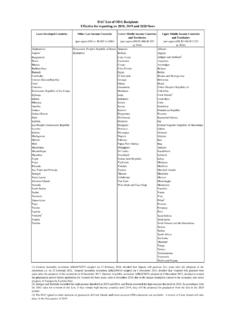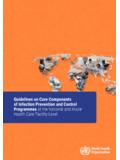Transcription of ˘ˇˆˇ˙˘ˇˆ˝ - UNICEF
1 ! "#$!%&# ! $ & "'(#$!%&#) # %*+$%(! $ ,!,+$!#$!%&#" !& ' i Table of Contents Table of Contents .. ii List of Figures .. iii List of 4 Acronyms .. v Foreword .. vii Acknowledgements .. ix Executive Summary .. x Chapter 1: Context For 2 Geography, and demographic 2 Socio Economic 2 Organization of the Health 3 Initiatives to improve maternal, newborn and child health in 5 Current Challenges in delivering Health 8 Chapter 2: Situation Analysis ..11 Trends in Neonatal and Child Morbidity and Mortality .. 11 Status of key neonatal and childhood illnesses and 13 Child Health 17 Child Welfare .. 23 Maternal Morbidity and Mortality Trends .. 24 Maternal Health 25 Chapter 3: Target Conditions and Delivery Of Key High Impact 28 Target Conditions .. 28 Modes of 28 Delivery of Interventions within the continuum of care.)
2 30 ii Chapter 4: Child Survival Strategic Framework .. 33 Strategic 33 Strategic Mission .. 33 Goal of 33 Strategic 33 Strategic 33 Guiding 34 Chapter 5: Priority Areas for Target Conditions .. 36 Neonatal Conditions .. 36 PMTCT and Paediatric AIDS .. 37 Pneumonia, Diarrhoea, Malaria .. 38 39 Maternal, Neonatal and Childhood Intevention Coverage Targets and 40 Chapter 6: Implementation 44 Strategic Objective 1 .. 44 To achieve universal access to selected high impact maternal, new born and child health interventions by 2015 (MDG4).. 44 Strategic Objective 2 .. 44 To strengthen capacity of health systems for leading, managing and providing high impact and low cost priority interventions for women and children by 44 Strategic Objective 3 .. 45 To strengthen individual, family and community capacity to promote key family and community practices to improve maternal, newborn and child health by 45 Strategic Objective 4.
3 45 To mobilize additional resources and diversify the resource base to support programmes for neonatal, child survival and 45 Strategic Objective 5 .. 46 To strengthen supervision, monitoring, evaluation and the Health Management Information system (HMIS) to report on progress towards the relevant MDGs .. 46 Strategic Objective 6 .. 46 iii To establish and sustain partnerships at all levels to support implementation of the child survival 46 Strategic Objective 7 .. 47 To strengthen logistics and supply systems for maternal, neonatal and child health 47 Strategic Objective 8 .. 47 To establish a coordination mechanism for implementation of the child survival strategy at all 47 Strategic Objective 9 .. 47 To strengthen multisectoral collaboration in health, improved living environment, education and alleviation of the plight of the child living in difficult 47 CHAPTER 7: Management and Coordination.
4 48 National Maternal, Newborn and Child Health Steering 48 Child Survival Technical Working 48 Managing 49 Organization of the Management and Coordination of the Child Survival Strategy Within Overall and Integrated MNCH .. 49 Specific Roles and Responsibilities .. 51 Chapter 8: Monitoring and Evaluation .. 57 Annex 1: MNCH interventions by Delivery Mode .. 59 Annex 2: Maternal, Newborn and Child Health Indicators .. 62 References .. 68 List of FiguresFigure 1: Early childhood mortality indicators over the years in relation to the MDG targets11 Figure 2: Causes of Under 5 Mortality in Zimbabwe .. 12 Figure 3: Outpatient attendance cases by under 5s .. 13 Figure 4: Causes of neonatal mortality .. 14 Figure 5: Summary coverage of key maternal, newborn and child health interventions in 17 Figure 6: Estimated coverage of ART in children, 2007 2009.
5 18 Figure 7: EPI coverage trends by antigen 1996 20 Figure 8: Major causes of maternal 24 Figure 9: Linkages in delivery 30 Figure 10: Proposed Organisation of the Management and Coordination of the Child Survival Strategy in the MOHCW .. 50 List of TablesTable 1: Continuum of care along service delivery and life 32 Table 2: Coverage of Maternal, Newborn and Child Health Interventions for the Target v Acronyms ANC Antenatal Care AIDS Acquired Immune Deficiency Syndrome ART Antiretroviral Therapy BEmOC Basic Emergency Obstetric Care CEmoC Comprehensive Emergency Obstetric Care CPR Contraceptive Prevalence Rate CSSC Child Survival Steering Committee CSTWG Child Survival Technical Working Group DDF District Development Fund DOT Directly Observed Treatment EOC Emergency Obstetric Care EPI Expanded Programme of Immunization ETAT Emergency Triaging and Treatment FST Family Support Trust GAVI Global Alliance for Vaccine and Immunization GMO Government Medical Officer Hib Heamophilus Influenza B HIV Human Immunodeficiency Virus HMIS Health Management Information System IGME Inter-agency Group for Child Mortality
6 Estimation IMCI Integrated Management of Childhood Illnesses IMNCI Integrated Management of Neonatal and Childhood Illnesses ITN Insecticide Treated Nets IPT Intermittent Presumptive Treatment IYCF Infant and Young Child Feeding MCH Maternal and Child Health MNCH Maternal Neonatal and Child Health vi MDG Millennium Development Goals MER More Efficacious Regimen MIMS Multiple Indicator Monitoring Survey MNCH Maternal Neonatal and Child Health MOHCW Ministry of Health and Child Welfare NIDs National Immunization Days MNCHSC National Maternal, Newborn and Child Health Steering Committee ORS Oral Rehydration Solution OVC Orphans and Vulnerable Children PHC Primary Health Care PMTCT Prevention of Mother to Child Transmission PNC Primary Care Nurse SdNVP single dose Nevirapine SP Sulfadoxine/ Pyrimethamine STI Sexually Transmitted Infections TB Tuberculosis UNICEF United Nations Children s Emergency Fund WASH Water Sanitation and Hygiene WHO World Health Organization ZDHS Zimbabwe Demographic and Health Survey vii Foreword Zimbabwe, like most Sub-Saharan African countries, bears a heavy burden of high neonatal and child mortality when compared to countries in other regions of the world.
7 The under-five mortality rate according to the Zimbabwe Demographic and Health Survey of 2005-5 is 82 deaths per 1,000 live births. The infant mortality rate is 60 deaths per 1,000 live births compared to 82 in 1999. Related to this is the neonatal mortality rate which was 36 per 1,000 live births in 2004 (State of the World s Children 2009, UNICEF ) compared to 29 per 1000 live births in 1999. The Multiple Indicator Monitoring Survey (MIMS) of 2009 estimates under five mortality rate and infant mortality rates at 94 and 67 deaths per 1,000 live births respectively. These indicators are unacceptably high. This demonstrates the need for us to scale up high impact interventions urgently, in order to reverse this trend and achieve Millennium Development Goal (MDG) number four. Neonatal conditions are the leading causes of mortality in children under five years in Zimbabwe.
8 The HIV epidemic continues to be a major challenge to child health. Approximately 105,740 children are living with HIV. Ninety percent of these infections are result of mother-to-child transmission. It is therefore imperative that efforts to prevent vertical transmission and rapid scale up of infant diagnosis are redoubled, so that infants are protected from acquiring HIV infection, and those infants who are infected are detected early and offered life saving Anti-Retroviral Therapy (ART) The country has made efforts to address child health issues in the context of several international agreements aimed at improving child health. The first international declaration underlining the importance of primary health care (PHC) was the 1978 Alma-Ata Declaration. The declaration expressed the need for urgent action by all governments, health and development partners, and the world community, to protect and promote the health of all people of the world.
9 Zimbabwe has re-affirmed its commitment to the Ouagadougou Declaration on Primary Health Care Approach, to facilitate the delivery of high impact, low cost interventions at high population coverage rates in order to reduce under 5 mortality by two thirds by 2015. This Child Survival Strategy provides a framework for addressing child health challenges currently facing Zimbabwe. It is an over-arching strategy for scale up of the national response to reduce the current levels of child mortality and morbidity in line with the MDG health related targets. The life cycle approach and continuum of care concept, starting with care from the home environment to health facility, guided the development of this strategy. The strategy will help bring together all national stakeholders to support one national Child Survival programme, one national Child Survival coordination mechanism, and one national Child Survival Planning, Monitoring and Evaluation Framework.
10 The Ministry of Health and Child Welfare would like to acknowledge the generous technical and financial contributions from all organizations and institutions that participated in the development of the Child Survival Strategy. The Ministry of Health would also like to extend its gratitude to all past and current donor partners who have offered specific support for child health activities, as well as financial and technical assistance for other aspects of health service delivery. viii Most importantly the Ministry of Health and Child Welfare would like to acknowledge the dedicated service and hard work of all health personnel at all levels of service delivery, who are at the forefront of efforts to improve child survival in the country. I therefore urge you all to implement this strategy and secure the health of our children over the next five years.

















